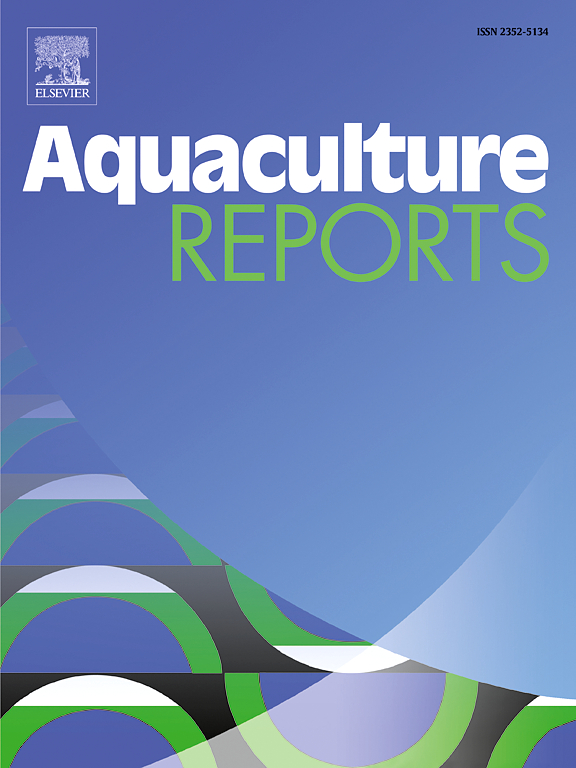丁酸钠减轻大口黑鲈黄曲霉毒素B1毒性
IF 3.7
2区 农林科学
Q1 FISHERIES
引用次数: 0
摘要
本试验旨在研究黄曲霉毒素B1 (AFB1)对大口黑鲈生长性能、脂质代谢、氧化应激、组织病理学和肠道菌群组成的影响,并评价丁酸钠(SB)的缓解效果。大黑鲈初始体重为3.38 ± 0.10 g,试验期56 d。试验分为CON组(不含AFB1的基础饲粮)、AFB1组(基础饲粮+1.0 mg/kg AFB1)和SB组(基础饲粮+1.0 mg/kg AFB1 +2.0 g/kg SB)。结果表明,与CON相比,AFB1显著降低了大口黑鲈的增重率,而在添加SB组中差异不显著。AFB1降低了血清TG水平,增加了CHO、HDL和LDL水平,而添加SB没有减轻这些影响。此外,与con相比,AFB1和SB组的血糖水平也显著降低。在氧化应激方面,AFB1暴露增加了肝脏抗氧化酶(包括GSH-Px、ACP和AKP)的活性,而SB添加增加了肠道过氧化氢酶CAT的活性,两者均显著增加了MDA含量。组织病理学结果显示,AFB1增加了肠道和肝脏的炎症反应,添加SB可减弱炎症反应。在肠道微生物组成方面,AFB1降低了大口黑鲈肠道微生物的相对丰度,而添加SB降低了厚壁菌门和支原体属的相对丰度,增加了变形菌门的相对丰度。综上所述,SB在一定程度上缓解了AFB1对大口黑鲈的负面影响,特别是在促进生长性能、肠道菌群和减轻炎症反应方面,为减轻AFB1在水产养殖业中的不良影响提供了科学依据。本文章由计算机程序翻译,如有差异,请以英文原文为准。
Sodium butyrate mitigates aflatoxin B1 toxicity in largemouth bass
The aim of this study was to investigate the effects of aflatoxin B1 (AFB1) on growth performance, lipid metabolism, oxidative stress, histopathology, and gut microbiota composition in largemouth bass, and to evaluate the mitigation effect of sodium butyrate (SB). The initial body weight of largemouth bass was 3.38 ± 0.10 g, and the experimental period was 56 days. The experiments were divided into three groups: CON (basal diet without AFB1), AFB1 (basal diet +1.0 mg/kg AFB1), and SB (basal diet +1.0 mg/kg AFB1 +2.0 g/kg SB). The results showed that AFB1 significantly reduced the rate of weight gain in largemouth bass compared with CON, whereas there was no significant difference in the SB supplemented group. AFB1 decreased serum TG levels and increased CHO, HDL, and LDL levels, whereas SB addition did not mitigate these effects. In addition, blood glucose levels were also significantly lower in the AFB1 and SB groups compared to CON. In terms of oxidative stress, AFB1 exposure increased the activities of liver antioxidant enzymes, including GSH-Px, ACP, and AKP, while SB supplementation increased the activity of intestinal catalase CAT, both of which significantly increased the content of MDA. Histopathological results showed that AFB1 increased inflammatory responses in the gut and liver, which were attenuated by SB addition. In terms of gut microbial composition, AFB1 decreased the relative abundance of gut microbes in largemouth bass, whereas SB addition decreased the relative abundance of Firmicutes and Mycoplasma genera and increased the relative abundance of Proteobacteria. In conclusion, SB alleviated the negative effects of AFB1 on largemouth bass to some extent, especially in promoting growth performance, gut microbiota, and reducing inflammatory responses, providing a scientific basis for mitigating the adverse effects of AFB1 in the aquaculture industry.
求助全文
通过发布文献求助,成功后即可免费获取论文全文。
去求助
来源期刊

Aquaculture Reports
Agricultural and Biological Sciences-Animal Science and Zoology
CiteScore
5.90
自引率
8.10%
发文量
469
审稿时长
77 days
期刊介绍:
Aquaculture Reports will publish original research papers and reviews documenting outstanding science with a regional context and focus, answering the need for high quality information on novel species, systems and regions in emerging areas of aquaculture research and development, such as integrated multi-trophic aquaculture, urban aquaculture, ornamental, unfed aquaculture, offshore aquaculture and others. Papers having industry research as priority and encompassing product development research or current industry practice are encouraged.
 求助内容:
求助内容: 应助结果提醒方式:
应助结果提醒方式:


